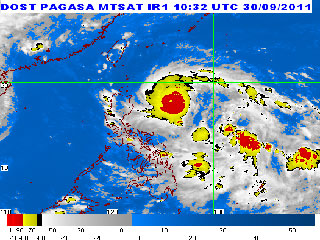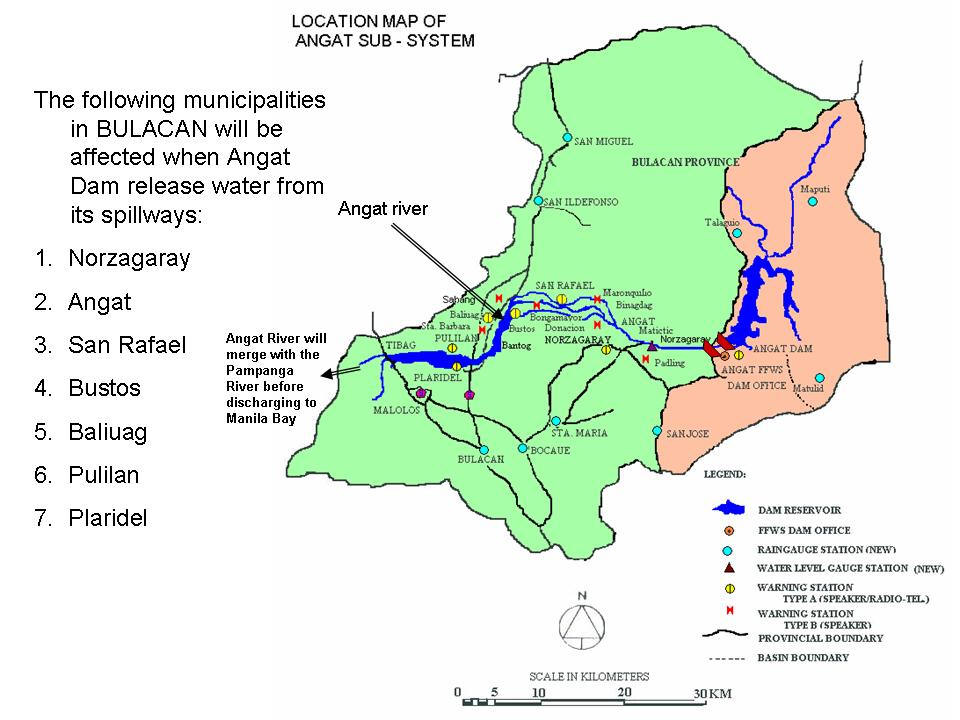No relief in sight for Central Luzon as dams release water
With desperate residents clinging to trees, the rice-growing provinces of Pampanga and Bulacan on Friday remain submerged as the government continued to release water from major dams in Luzon to create space for the anticipated rainfall from the approaching Typhoon Quiel. The alternative to the flows from the dams now, according to PAGASA and Napocor, could be even greater catastrophe.
Flooded areas are indicated by blue pins. Major dams are indicated by flags.
Click here to view this in a larger map. Authorities said it is necessary to let the water escape to avoid a dam collapse causing rampaging waters to wash away people and houses. Chest-deep floods in Pampanga and Bulacan forced families out of their homes and into evacuation centers that later flooded as well. Those who did not flee were trapped on the roofs of their houses or in trees crying out for rescue. But government is insisting that water must be released continuously from the major dams, mostly in Central Luzon, with two tropical cyclones approaching one after the other less than a week after “Pedring" lashed through Luzon starting last Tuesday. Elmer Caringal, state hydrologist from the Philippine Atmospheric Geophysical and Astronomical Services Administration, said it would be best to keep the floodgates of at least six major dams open and let controlled volumes of water gush out so that the facilities can make room to accommodate the rains Typhoon Quiel, and later on Tropical Cyclone Ramon, will dump on Luzon.


Don't blame the dams Napocor's Gana said the water from the dams have little bearing on the flood situation currently plaguing Bulacan and Pampanga. Gana clarified that the massive flooding was caused by rainwater rushing down from the mountains of Nueva Ecija and Pampanga. He said rainwater coming from these two provinces converge within the Pampanga River basin, while the water released from the Angat Dam accounts for only 5 percent of the water in the river basin. Even if Angat Dam did not open its floodgates, affected communities would have suffered the same fate due to the sheer volume of water earlier dumped by Typhoon Pedring, according to Gana. Not climate smart Jose Ma. Lorenzo Tan, chief executive officer of the World Wildlife Fund Philippines, said releasing dam water into "existing rivers along the Bulacan bayshore... is not climate smart." Government instead should build additional floodways and retention basins and set up forest recharge areas, Tan said. "Central Luzon feeds Manila. We cannot ignore this," Tan said. In Isabela, classes in elementary and high school have already been suspended after the province was placed under Storm Signal No. 2. The province remains in a state of calamity in the aftermath of “Pedring." Local officials are closely monitoring water levels in the Cagayan and Dinakawan Rivers, and Magat Dam, which was less than 2 meters from spilling level as of 6 p.m. Friday. The dam continues to discharge water through seven of its floodgates. — VS/HS, GMA News



